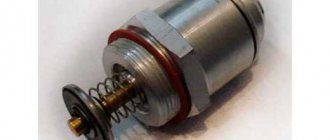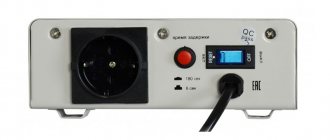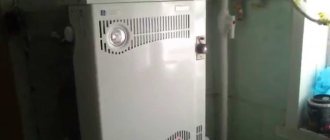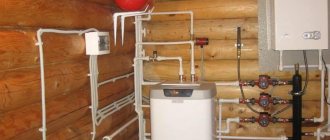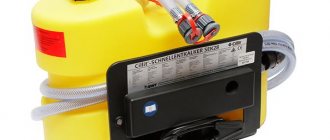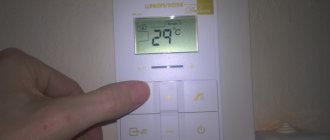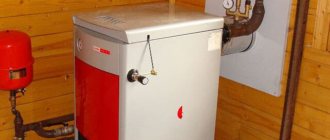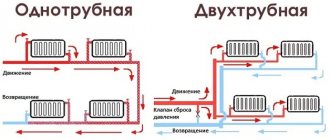Nowadays, gas boilers play a very significant role in heating in many countries around the world. After all, from large cities to remote villages, gas has been supplied. And therefore, gas heating gradually replaced wood-burning stoves. The gas boiler is located inside the building in a specially designed utility room. After that, a heating circuit is connected to the equipment, a chimney is connected and the boiler is powered from the gas pipeline. For all types of boilers: floor-mounted, wall-mounted and others; There is such an important indicator as efficiency.
Manufacturing features and choice of materials
In addition to knowledge, skills, drawings and diagrams, for the manufacture of heating equipment you need to stock up on materials and tools. What is needed to make equipment?
Materials and tools for making equipment
Materials:
- Heat-resistant steel plates 4-5 mm thick to create a firebox.
- Steel sheets 2-3 mm thick for making the body.
- Steel pipes for the heat exchanger, the length and diameter of which are calculated individually.
- Metal pipes for the chimney.
- Arched slab and grate.
- Ash pan combustion chamber door.
- Heat-resistant brick.
- Cement solution.
Tools
- Welding equipment with a supply of electrodes.
- Device for gas cutting.
- Grinder with discs.
- Pipe bending machine.
- Level, tape measure, marker.
Recommendations for the manufacture of equipment
Homemade boilers for heating a private home are usually made of metal. It is almost impossible to make a cast iron firebox at home; buying a new one will be expensive. Many homeowners order them from craftsmen who specialize in the manufacture of heating equipment. In order not to encounter defects in the heating operation in the future, it is recommended to take part in the process. The purchase of materials and components, assembly of the heating boiler, installation and testing of the finished device must take place in your presence.
Since the combustion chamber of a solid fuel device has a very high temperature, it is made of expensive alloyed heat-resistant steel (stainless steel) 5 mm thick. In order to save money and simplify welding work, ordinary thick sheets of steel are often used instead of stainless steel. Such products are short-lived, and steel walls can become deformed due to temperature changes.
A reliable and efficient homemade solid fuel installation will cost less than a factory one
The water jacket is made of ordinary metal St 20 3 mm thick. This steel is used in the production of pipes for hot water and steam. Therefore, smoke pipes with a diameter of 48–76 made of the same grade of steel are suitable for the heat exchanger. The design of the shirt should be as rigid as possible. This quality is ensured by welding stiffening ribs to the outer walls of the firebox in increments of 120-150 mm. The outer walls of the tank are also welded to the ribs.
The doors of the blower and firebox must be double-layered. Between the metal layers it is necessary to insert a thermal insulation layer of asbestos, basalt fiber or a combination of both. The same materials can be used to insulate the body. The hinges on the doors are made adjustable, and the recesses are sealed with asbestos cord. To avoid burning your hands, the locking handles are equipped with ebonite or textolite nozzles.
Rules for connecting radiators and their modernization
Other elements of greatest interest are batteries and pipes. To increase the efficiency of a heating battery, you must initially choose the right model. Ideally, it should have maximum thermal conductivity. This applies to aluminum and bimetallic batteries. If we take the efficiency of heating radiators, the table will show significant differences from cast iron ones. However, it should be borne in mind that the cooling of aluminum will take place much faster. This material does not accumulate heat. In addition, in cast iron there is an uneven distribution of the energy received.
Heat transfer characteristics of radiators depending on the degree of water heating
For comparison, you can consider the table of efficiency of steel-type heating radiators.
The larger the area of the battery, the faster the air in the room will heat up. But you need to take into account the degree of cooling of the coolant. It is desirable that the operating temperature of the radiators in the house is the same.
Radiator connection methods
Changing the efficiency of the radiator depending on the connection method
Having decided on this parameter, you can move on to the main subtleties of increasing the efficiency of the heating battery. The main one is the method of connecting to the system. It is best to make the connection to the system on one side of the device. Then the coolant will go through a full cycle through the battery.
But in practice this is not always possible. Therefore, they prefer to choose the “golden mean” - the upper supply and the lower connection to the return pipe. This technique has the following advantages:
- You can increase the efficiency of the heating battery in other ways by compensating for 2%;
- Optimal length of the highway, which also affects the efficiency of the entire system;
- Possibility of installing a Mayevsky tap and an automatic thermostat.
Installing radiators for maximum efficiency
The value of the coefficient for various options for arranging radiators
The main rule for installing radiators of any type is optimal heating of the room. Those. they should be located in the area of the room where heat loss will be maximum. This primarily applies to window structures.
In order to make heating with high efficiency, the window sill must overlap the upper plane of the radiator by 2/3. You also need to consider the recommended distances from the structure to the walls and floor:
- From the window sill to the top of the section – 100 mm;
- From the floor surface to the battery - 120 mm;
- From the rear panel of the radiator to the wall - 20 mm.
In this way, maximum efficiency of the entire heating system can be ensured. Convection currents of warm air will be partially retained in the window sill area, heating the wall and reducing heat loss through the window.
Underfloor heating circuits
Like the collector circuit, a water-heated floor is installed during the construction or renovation of a two-story house. There are 2 ways to install underfloor heating:
- embedding pipe coils in a cement-sand screed;
- layout of heating circuit pipes in heat-distributing metal plates without pouring screed.
The ends of pipes Ø16 x 2 mm, laid with a snake or snail, are connected to the comb, which was mentioned above and described in detail in a separate publication. A manifold with a mixing unit or RTL thermal heads ensures the supply of coolant to the circuits with a temperature not exceeding 50 °C.
The advantages of heated floors are obvious - real energy savings of 15-20% due to heating the surface to a temperature of 20-25 ° C and comfort for those living in the house. Now about the negative points:
- Installing a heated floor in a two-story home is not a cheap undertaking. In terms of the cost of materials and installation, this is the most expensive option for space heating.
- Heating circuits, especially in cement screeds, are very inert in terms of adjustment. Imagine, a cold monolith reaches operating mode within 24 hours. To prevent the room from overheating, a third of the required heating power should be supplied by batteries that quickly respond to changes in air temperature.
- In the event of a malfunction or water leak in the circuit, the concrete screed will have to be broken.
Method for installing heated floors without cement screed
Despite the problems listed above, heated floors are being used by homeowners more and more often - the heating is too comfortable and the fuel savings are noticeable. Unlike other heating systems, heating circuits do not spoil the interior of the premises at all.
How much is this in money
To understand how much this costs, let’s determine the heat losses of the building through the walls and calculate how much gas is needed to compensate for them.
At an outdoor temperature of 0°C and an internal temperature of +22°C, heat loss per 1m2 of wall will be 7.85 W/h. We will also need such values as the duration of the heating period - 150 days, wind speed - 3 m/s and gas price - 6.98 UAH/m3.
| Option A | Option B | |
| External wall area, m2 | 162 | 216 |
| Daily heat loss, kW | 24,53 | 32,71 |
| Annual heat loss, kW | 3 680 | 4 906 |
| Gas consumption, m3/year | 528,7 | 704,9 |
| Annual costs, UAH | 3690 | 4 920 |
| Overpayment for heating, UAH/year | 1 230 |
By changing the shape of the building, its potential heat loss was reduced by 1227 kWh/year, which at a gas tariff of 6.98 UAH/m3 will be 1230 UAH/year. On the one hand, this is not much, but on the other hand, it does not require any additional costs.
In addition, the following must be taken into account:
- Energy resources are constantly becoming more expensive, and savings will only increase every year.
- The worse the thermal insulation qualities of the wall material, the greater the savings will be. For a wall made of shell rock it will be 3,169 UAH/year, for hollow brick - 4,036 UAH/year, foam concrete - 2,885 UAH/year.
- The calculations used an average street temperature of 0° C, but the colder it is outside, the greater the heat loss. For the example above, at a street temperature of -10 °C (instead of 0 °C), the overpayment for heating will be already 50% higher - 1789 UAH/year.
- Every corner in the building is a bridge of cold. A square-shaped house has four corners, while an L-shaped house has six. That is, in the second case you get two additional cold bridges (which will also increase heat loss by 5-15%). If the building has an even more complex shape, then there will be more angles.
- If you decide to insulate the house, then in the second case the insulation area will be 54 m2 larger. If the price of foam insulation is 400 UAH/m2, the overpayment will be 21,600 UAH.
- Calculations were made for gas heating. When using alternative heat sources, heating costs will be different.
Decorative lattice - master class
To make a screen for a niche radiator design, you need to take several steps:
Making a template in the form of a design you like from waste plywood. Going through the template with a jigsaw. It needs to be processed with a milling cutter
It is important to achieve ideal transitions between the details of the ornament. To close the niche with the battery you need to prepare several templates. Depending on the width of the niche, you should choose your number of fragments. They need to be sanded and coated with special enamel.
It is important to make special holes for fastening. After the enamel has completely dried, the parts are sanded and painted with the required shade of paint. The parts are secured using fasteners.
What's next?
It must be said right away that there are a number of requirements for a gas boiler. For example, it is necessary to have a special exhaust gas outlet with a deflector on top. In addition, everything must be perfectly connected. In other words, it is prohibited at the legislative level to use heating systems operating on this type of fuel without the necessary checks and obtaining the appropriate documentation. Therefore, before installing a self-made gas boiler, you must definitely call a specialist who deals with the above.
The fact is that such equipment belongs to devices that have an increased danger. And for a self-made boiler, you must obtain permission for installation from a gas service. And she, in turn, needs to provide a certificate for the product, moreover, the original, not a copy or photo.
You need to understand that getting such paper is not easy, and most often it costs a large sum of money. In addition, a minimal deviation from all prescribed standards leads to a complete ban on the use of homemade installations. This is a strong argument in favor of the fact that making a gas boiler with your own hands can only be done by a person who has extensive experience in installing and servicing such units. This refers to the complete set and assembly of the system from individual components, each of which is manufactured in compliance with GOST, and the use of hand-made parts is reduced to a minimum and is permissible only in non-critical areas.
When all issues with the relevant services have been settled, the boiler can be installed. Unfortunately, there are rare cases when homeowners manage to do this without the approval of technical supervision authorities, which is a gross violation of the law and is fraught with unpredictable consequences.
Instructions for enhancing heat transfer
- color of batteries and cleanliness of their surface;
- correct heat reflection;
- increasing the size of radiators;
- circulation of air coming from a heat source.
To increase the efficiency of the heating system in an apartment or private house, home craftsmen will first have to remember the school physics course. As you know, the heat transfer of dark-colored objects is much higher than that of light-colored surfaces.
The conclusion suggests itself: if you need to increase the efficiency of heating a room, it’s enough to start by repainting the radiators in a dark color. It has been experimentally proven that a battery painted bronze or brown produces 20–25% more heat than a similar white radiator.
However, before painting the entire heating system or part of it, it is recommended to carry out... wet cleaning! The fact is that a layer of dust significantly reduces the heat transfer of the entire heating system, acting as thermal insulation. Thus, keeping the battery clean is not just about meeting the requirements of hygiene and home aesthetics, but also a simple method for increasing its efficiency.
Dust is not the only “enemy” of warm radiators during the heating season. Numerous layers of paint on radiators also act as thermal insulation. If you are planning cosmetic repairs of the heating system without replacing its components, then the craftsmen advise removing the previous layers of paint and only then repainting the pipes and radiators.
Advice: when painting batteries, it is better to choose special enamels with minimal thermal insulation.
DIY heat-reflective screen
The battery has one negative property - it heats the air equally in all directions. Thus, part of the heat goes into the outer wall. This situation can be improved on your own. To do this, you will need to attach a reflective screen to the wall behind the battery. Its role can be played by ordinary foil, which is glued directly to the wall or to a layer of insulation.
It is secured with liquid nails. Some homeowners who don't want to spend too much time on this process simply place a piece of foil of the appropriate size behind the radiator without securing it with anything.
Instead of foil, you can use a black metal surface with corrugated vertical ribs. It absorbs heat, acting as an additional convector.
More sections - stronger effect
heating systems
If the repair has already been completed, and an error was made in calculating the power of the heating system, the master can always eliminate this mistake by carrying out a local reconstruction. Sectional type batteries are “strengthened” by adding sections, and for panel structures a different method is used - replacing the panels with more powerful ones. Of course, all work of this kind is carried out only in the summer, when the central heating radiators are turned off.
You will not have to pay more for heating if the apartment does not have coolant flow meters installed. Regardless of the number of radiators or their size, you will pay fixed bills during the heating season, but the room temperature will increase significantly.
Advice: in spacious rooms it is better to install multi-section radiators, because as the radiator area increases, its efficiency also increases. It should be noted that if the power of the entire system is initially calculated incorrectly, then increasing the number of heat sources in the network is not the best way to increase its heat transfer. By using this method, you can greatly increase the load on the network.
https://www.youtube.com/watch?v=nSewFwPhHhM
There are several simpler and more affordable ways to increase the radiator area without purchasing additional sections. We are talking about an aluminum screen or a protective casing made of steel elements, which are heated directly by the battery, increasing its area and efficiency.
Heating system requirements
Regardless of whether an old system is being modernized or it is being designed from scratch in a newly built house, the first thing to start with is becoming familiar with the regulatory documentation. It describes in detail how the equipment is put into operation and describes the subtleties and features of its further use.
After spending some time on this, you can be sure that the heating system will last for many years. From year to year, the requirements are adjusted and updated. But there are some principles that every cottage owner should know. The first thing that needs to be ensured when installing a heating system is explosion and fire safety.
For safe operation during the installation process, you need to ensure free access to the equipment for cleaning and regular checks.
The list of rules that will help make a private home not only cozy, but also safe to live in, should include the following aspects:
- The temperature of open heating system elements should not be higher than that recommended by the manufacturer.
- Equipment and all appliances should be properly insulated. This will avoid burns, eliminate the formation of moisture and reduce heat loss. In addition, hot elements can ignite dust, gas or aerosol in the room.
- When using a coolant, the temperature of the latter must be 20 degrees Celsius lower than its evaporation or self-ignition temperature. For example, if the system uses water, then it must be prevented from boiling. An excellent solution would be to raise the pressure.
There are also operational requirements for the heating system. After all, any equipment must be as strong, durable, easy to operate, silent and easy to repair as possible.
It is better to order equipment from trusted manufacturers. Such companies produce truly high-quality products, since they stand behind them with their own name.
By choosing a boiler, radiators and pipes that best meet the listed criteria, you can save yourself from many problems.
What should an energy efficient boiler be like?
The characteristics specified in the documents and rich practical experience show that imported boilers have the highest efficiency
European manufacturers pay special attention to the use of energy-saving technologies, which allows them to get the most out of their equipment. Let’s make a “portrait” of an ideal gas boiler:
modulation burner - automatically adapts to the operating mode of the system, minimizing the percentage of underburning;
heating the coolant no more than 70 degrees, exhaust gases - up to 110 degrees, which ensures an optimal balance of efficiency, it is desirable to have a condensation heat exchanger;
coaxial chimney - a closed combustion chamber requires the equipment to have a pipe-in-pipe channel for removing combustion products, which allows heating the air flow from the street;
recirculation system - allows you to use the heat of exhaust gases to heat the room.
Of course, such an ideal boiler does not exist, but a list of the best technical solutions will help you choose a worthy model.
Heat loss when removing flammable gases
When natural gas burns, it releases carbon, carbon dioxide and water vapor. In boilers with a conventional heat exchanger, this entire cocktail is removed to the outside almost immediately after formation. But modern manufacturers offer condensing boilers that allow you to use the heat of combustion products to the maximum. Inside such a heat exchanger, water vapor condenses and releases energy. Cooled moisture must be periodically drained and disposed of in a special way, since it contains acid.
Typically, the declared efficiency of condensing boilers exceeds 100%, which seems incredible from a physics point of view. To understand this issue, it is necessary to distinguish between two concepts:
NUTS (lower specific heat of combustion) - energy obtained from fuel when all combustion products are released into the external environment;
VUTS (highest specific heat of combustion) is the amount of energy that takes into account the potential of water vapor.
In the regulatory documentation, all calculations are carried out using NUTS. If we take into account the energy of water vapor used, but calculate based on the lower specific heat of combustion, we get figures that exceed 100%. In general, the difference between NUTS and VUTS is approximately 11% - this is the maximum difference in the efficiency of boilers with different heat exchangers.
Construction of a solid fuel boiler
The design of the solid fuel boiler is such that it can operate on both wood and coal. What is noteworthy is that to install these units you do not need to obtain an installation permit. In addition, they do not need frequent checks and examinations with the invitation of specialists. Typically the unit has a cylindrical or rectangular shape.
Components present in all boilers:
- Furnace or combustion chamber. Firewood is placed in it and then burned. Due to this, heat is generated.
- Blower (ash pan) is a hole that allows air to pass through to the combustion site. It is part of the firebox and is separated from it by a grate, through the cracks of which the slag remaining after the combustion of firewood pours out.
The operating principle of a new type of boiler is based on pyrolysis combustion of fuel. In them, the process of obtaining thermal energy is more complex, but effective.
In pyrolysis boilers, flammable gas is released, obtained during the decomposition of wood under conditions of lack of oxygen. This steam is mixed with air and burns with a torch in the heat exchanger zone. The design is equipped with a loading chamber and a firebox.
After placing coal or firewood in the loading chamber, the raw material enters through a ceramic burner into the combustion chamber, where a torch is located at the outlet. Adjusting the gas supply allows you to keep the coolant temperature at 65–68 ºС.
The heat exchanger is one of the most important components of a high-efficiency boiler. Heat is transferred through the walls of its tubes. By design, the heat exchanger resembles a coil, which is located in the flame zone of the combustion chamber. With new units, in most cases, it is designed so that the firebox itself is located inside the coil, thereby reducing heat loss.
Heat exchangers are divided into two types:
- Steel. Such units are quite lightweight, easy to install and inexpensive. However, their service life is about 10 years. Cannot be repaired.
- Cast iron. They are characterized by a long service life - over 20 years. Such boilers are resistant to corrosion. If one of the sections breaks, you can replace it with a new one.
Main types of heat loss
Let's start with the mechanical one. In essence, this is the scheme. During gas combustion, oxygen must be supplied to the furnace. For this purpose, a small chamber with a door is installed in the design of the gas boiler itself. They call it a blower. By slightly opening or closing the damper door, we let fresh air enriched with oxygen into the combustion chamber.
If you open the damper more than the required setting, the gas will not burn completely. A draft forms inside the firebox, drawing out some of the unburnt gas along with the combustion products. Accordingly, less thermal energy will be released. This is a minus, it is a drop in the efficiency of the gas boiler.
Chemical heat loss, on the contrary, is a large lack of oxygen in the combustion chamber. That is, the damper is closed too much. Without oxygen, the gas will not burn completely and again, along with combustion products, will fly out into the chimney. In this case, the drop in efficiency will be the largest, up to 7%.
Rule of successful statistics
What is the point of bringing a tank onto the field? Of course, the goal is to remain in a combat-ready state for as long as possible and at the same time accomplish something useful, for example, inflict incredible damage, illuminate enemy tanks, prevent the capture of a base, and so on.
You should not immediately merge, even if your nickname is at the end of the list. You need to be patient and wait. As soon as it becomes clear what positions the tanks occupy, you can begin to plan your actions.
It also happens that players on a team merge, and you have to be left alone with enemy vehicles. Just don’t give up right away, even if it seems like you can’t handle it, continue the game. Sometimes such tactics help to increase the number of unfinished tanks and recapture HP.
What changes can be made to the design?
To increase the efficiency of wall-mounted or floor-mounted gas boilers, special turbulators can be installed between the combustion chamber of the unit and its heat exchanger. This is the name for special plates that can significantly increase the area of heat energy extraction.
The operation of the boiler can also be controlled using temperature sensors. Such devices are installed in the premises of the house and turn on/off the burner of the heating unit depending on the air warming up to the temperature set by the owners
When using sensors, it is important to correctly configure and synchronize the operation of the boiler in accordance with the latest readings
The burner of gas heating units is turned on when the air temperature in the premises drops below the specified parameters using a special “lighter”. This is the name given to a small burner whose gas never goes out. Such a “lighter” cannot burn a lot of blue fuel. However, during the season, due to its operation, several cubic meters of blue fuel are often burned. To reduce losses, the usual “lighter” in the boiler can be replaced with a “piezo”. Such a device will work no worse than a traditional one, and the savings from its use are quite significant.
Cleaning the combustion chamber
Blue fuel is distinguished primarily by the fact that its combustion does not produce too much soot. Of course, it is necessary to clean the furnace of a gas-fired boiler less often than of solid fuel equipment of this type. But it is still necessary to wash the combustion chamber of such heating units from time to time. Experts believe that owners of gas boilers need to do such cleanings at least once every 3 years.
Step-by-step technology for making a solid fuel boiler with your own hands
It will not be possible to make high-tech equipment at home, but a simple boiler using wood or coal is quite suitable for heating a house of any size. The main thing is to correctly create a diagram, calculate power parameters taking into account the length of the network, the presence of pipeline branches and other nuances.
Tools and materials for work
Set of tools:
- welder;
- grinder with discs for cutting and grinding metal;
- drill with metal drills;
- gas keys: No. 1, 2;
- hammer;
- open-end or folding wrenches, screwdrivers;
- pliers;
- square
Materials:
- steel sheet with a thickness of 5 mm for the boiler, with a thickness of 7 mm for the grate;
- steel corners 50x50 for the boiler frame;
- stainless steel sheet for storage tank;
- steel pipes for the heat exchanger in the form of a coil with a diameter of 32–50 mm.
Additional materials may be required according to the drawing. Personal protective equipment will be useful - gloves, mask, goggles.
Manufacturing of the body and heat exchanger of a solid fuel boiler
Most often, the body works as a combustion chamber, therefore it is the basis of the structure. To prevent the walls from deforming under the influence of heat, the enclosing structure is made of two layers; dry, clean sand is poured into the space between the sheets - it reduces heat and serves as a fixation of shape stability.
The outer and inner shells of the body are frame. To increase rigidity, to strengthen the structure, the walls of the combustion chamber are sheathed with a steel angle or stiffeners made of a metal profile.
The front wall is cut for holes for the podzolnik and the hopper door. It is most convenient to first mark the cutting area with chalk, then drill several holes in the corners of the drawing, then cut.
After completing the blanks for the housing, we begin to form the heat exchanger. You will need parts from a water pipe of the required cross-section; they should be joined by welding into a sealed circuit of the maximum possible length - this will increase the area of contact with the heater and increase the efficiency of the device.
Assembly phase
All blanks and elements must be assembled. When thinking about how to make a boiler, it is better to assemble it at the installation site, especially if the finished structure is massive. At the installation point, a concrete foundation is first laid, the unit is fastened with anchors, so the pedestal is equipped with mortgages, fixed by welding.
The wood-burning boiler is assembled with your own hands from the body, then equipped with parts and casing. Before welding, the parts are chamfered, after which the seams are cleaned of slag and ground. Inspect the seams and check their tightness. If any gaps are detected, boil again.
The next stage is the installation of the grate and heat exchanger. The coil is connected to the heating circuit by welding, taking into account the angle of inclination so that the coolant is transported naturally.
After assembly, the entire structure is painted with heat-resistant paint. First, the surface of the body is sanded, then primed, and only then painted. Paint in 2 layers, first drying one layer, then applying the second.
If you have any questions, this video will help - how to make a water boiler with your own hands:
A novice craftsman can make the simplest boiler from a pipe with his own hands. A liquefied gas cylinder is suitable - the steel structure is thick and durable, which is exactly what is required for the manufacture of a solid fuel heater.
How to increase the efficiency of a gas boiler
To organize heating systems for a private home, owners often use gas boilers. This is due to their good performance, a wide range of equipment, and the low cost of the fuel itself. Gas-powered devices are reliable, durable, and easy to operate.
The issue of heating is especially relevant in the winter season. Problems in the functioning of heating equipment affect not only the comfort, but also the health of the residents of the house. The design of a heating system is carried out at the stage of construction or repair work. It is at this time that the issue of choosing a boiler is decided. The main parameter that is relied on when purchasing equipment is its power. The quality of functioning of the heating system depends on it.
Checking the efficiency of a gas boiler
Over time, gas boilers can reduce their power, which is due to wear of parts, non-compliance with operating rules, and inadequate maintenance. If you do not plan to purchase new heating equipment in the near future, you should look for ways to improve the operation of a gas boiler.
How to calculate power
Before purchasing heating equipment for servicing a private home, it is necessary to calculate the power that would be enough to maintain high-quality operation of the boiler. If you do not have sufficient experience and knowledge, seek help from professionals, as mistakes at this stage will certainly affect the performance and durability of the equipment.
Note! Problems arise not only in case of insufficient power of heating equipment, but also in case of its excess. There are special formulas for calculating power
Using them, you can independently calculate which boiler is suitable for servicing your home.
When calculating the power of a gas boiler, the following parameters should be taken into account:
- average temperature in the winter months in a given area;
Gas boiler operation and heat loss - what materials the house is built from;
- what materials were used to insulate the house, and whether they were used at all;
- living area of the house.
You can use special formulas to calculate the power of heating equipment for a private home.
Note! The power of a gas boiler also depends on whether hot water is required in the house
What does boiler efficiency depend on?
To find a solution on how to increase the efficiency of a gas boiler, you should first become familiar with what parameters this coefficient depends on. Technical documents indicate a fairly high efficiency index, but the real percentage is almost always far from enough. The main parameters that affect the efficiency of a gas boiler:
- whether the type of fuel burned corresponds to the furnace where it is burned;
- what is the technical condition of the heating equipment;
- load on the heating system;
- how well the heating system in a private house is organized;
Scheme of gas boiler efficiency formation - quality of gas used for heating the house.
There are other parameters that affect the efficiency of a gas boiler. In order for the heating system to function most efficiently, all criteria on which the boiler efficiency depends should be taken into account.
Types of heat loss
There are nominal and real efficiency. The real one is always less than the nominal one. This is also due to the fact that there are different types of heat loss. The following types of heat loss are distinguished:
- Physical underburning.
The indicator depends on how much excess air, which does not take part in the formation of thermal energy, is present in the equipment during fuel combustion. Its value is also influenced by the temperature of the exhaust gases. In winter, during severe frosts, when the boiler is operating at full capacity, physical underburning can reach 20%. Heat loss from gas heating and low efficiency - Chemical underburning. The value of this criterion increases depending on the amount of carbon monoxide. Carbon does not burn in heating equipment and exits through the chimney, however, it has the ability to produce large amounts of thermal energy. Carbon monoxide is formed due to the combustion of carbon. Heat loss from chemical underburning ranges from 5-7%.
- Mechanical underburning is typical for solid fuel heating boilers. This is a loss of efficiency as a result of incomplete combustion of fuel and the formation of ash. The percentage is insignificant - only 1-3.
Types of heat loss
Having understood what efficiency is in heating boilers , it is necessary to analyze the reasons that prevent you from achieving maximum efficiency from the equipment.
Mechanical underburning - to maintain the combustion process, fresh air must be supplied to the burner. For this purpose, the boiler is equipped with a miniature door - a vent. If this window is open too much, a draft will form inside the chamber, drawing some of the unburnt gas into the chimney. In this case, the efficiency drops by several percent.
Chemical underburning - if there is a lack of oxygen, the gas also does not burn completely, so it is sent up the chimney. In this case, the efficiency can decrease by 7%.
General heat loss - lack of proper thermal insulation of the roof steals 10-25% of efficiency. Walls that conduct heat well take 20-30% of the boiler's power. Old windows and doors deprive you of 15-25% of heating. Flooring on the ground reduces heating efficiency by 3-6%, and improper arrangement of the ventilation system removes 30-40% of heat from the room.
Conclusions and useful video on the topic
The first video will help you understand how to clean the boiler heat exchanger, which will help to significantly increase its efficiency.
The following video will give you an opportunity to understand how to clean a gas burner in order to increase the efficiency of the boiler.
Experience shows that maximum efficiency from a boiler can be achieved with its systematic maintenance with timely cleaning of burners and heat exchanger from combustion products and dirt. And also with proper placement and use of radiators. In addition, only modern high-tech equipment can be highly efficient.
Have you noticed a discrepancy or want to supplement our material with useful recommendations for increasing the efficiency of the boiler? Leave your comments, participate in the discussion and ask your questions to our experts - the feedback form is located below.
Final stages
At the final stages the following operations are carried out:
You can also modernize the gas burner yourself. This will significantly increase the amount of heat generated. The following steps are required:
After improvement, the boiler flame will be located between the tubes. As a result, they will become seriously warm.
